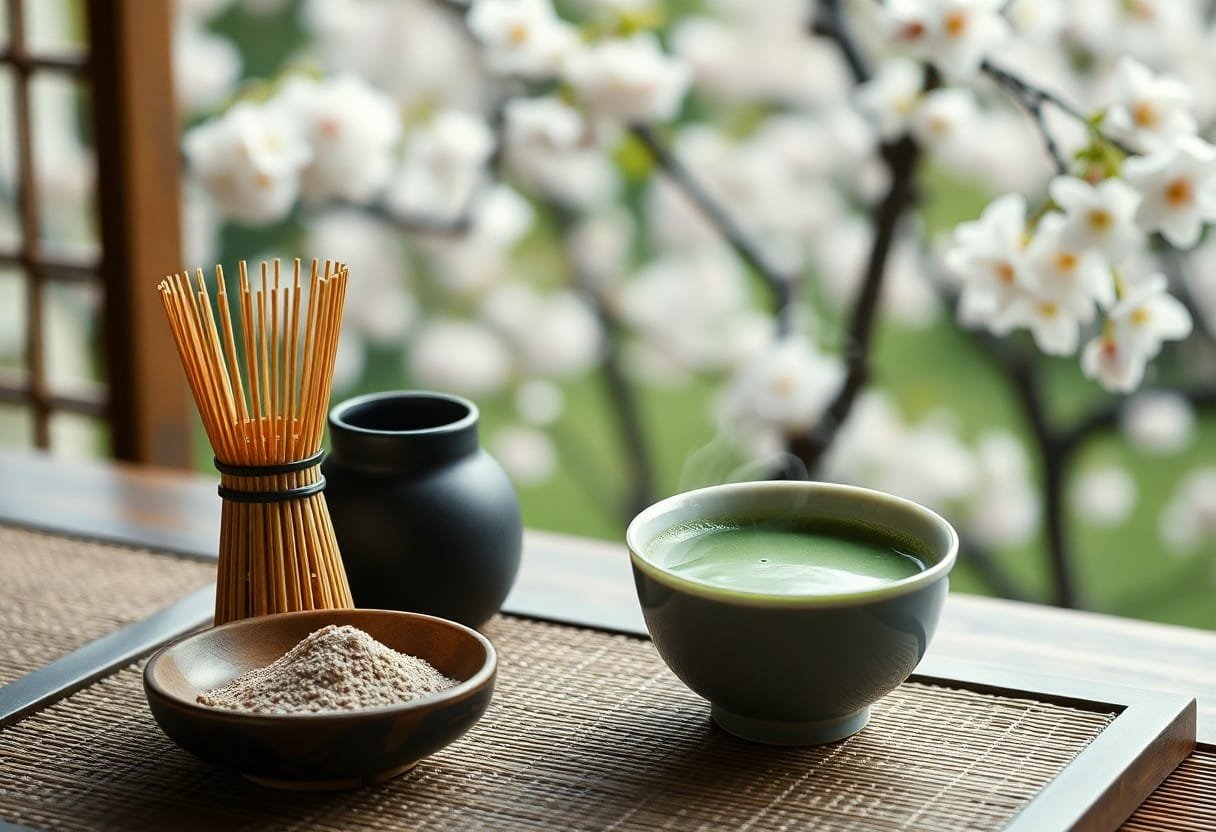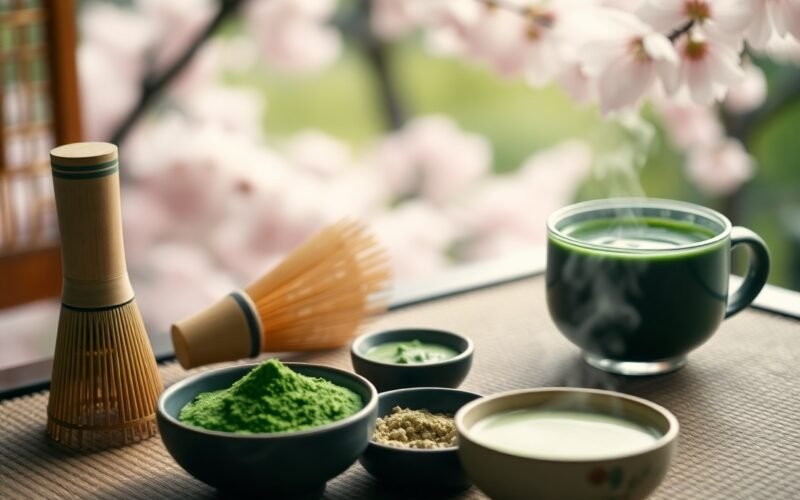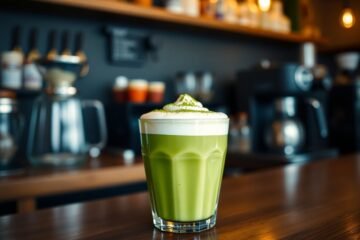Perfecting your matcha latte is more than just following a recipe; it’s about embracing an ancient ritual that honors the rich tradition of tea preparation. In this journey, you’ll discover the secrets behind selecting high-quality matcha, the art of whisking, and the meditative practice that surrounds this soothing beverage. Understanding these elements will not only enhance your experience but also elevate your latte to a level that resonates with the soul of Japanese culture.

Key Takeaways:
- The quality of matcha powder is important; selecting premium matcha enhances flavor and health benefits.
- Mastering the traditional whisking technique with a bamboo chasen ensures a frothy and well-integrated latte.
- The addition of ingredients like milk and sweeteners should complement, not overpower, the matcha’s unique taste profile.
The Sacred History of Matcha
The story of matcha is steeped in tradition and cultural significance, tracing back to ancient China before making its way to Japan, where it became woven into the fabric of Zen Buddhism. This finely powdered green tea evolved over centuries, transforming from a simple drink into a sacred ritual that embodies mindfulness and meditation. You can explore the intricacies of this ancient beverage and learn How to Make the Perfect Matcha Oat Milk Latte at Home.
A Journey Through Time: The Origins of Matcha
Matcha’s origins can be traced back to the Tang Dynasty (618-907 AD), where it was consumed as a compressed tea made from powdered leaves. The subsequent Song Dynasty (960-1279 AD) saw the emergence of the whisking method, which paved the way for the matcha we know today. The art of tea drinking gained traction in Japan in the 12th century, thanks to Buddhist monks who brought its essence over, fundamentally intertwining matcha with Japanese culture.
The Cultural Significance of Matcha in Zen Buddhism
In Zen Buddhism, matcha is more than just a beverage; it represents a deep connection to the present moment. Ritualized tea ceremonies became a practice of mindfulness, emphasizing meditation and contemplation. By engaging in the meticulous preparation and consumption of matcha, practitioners cultivate awareness, creating a sacred space for reflection. The soothing, velvety texture of matcha not only calms the spirit but also stimulates a meditative state, fostering a sense of harmony with the world around you.
Zen monks believe that matcha can enhance one’s focus and clarity, making it an vital part of their rituals. Each aspect of the tea ceremony—from the selection of the matcha to the rhythms of whisking—promotes a state of peace. This ceremonial approach has transcended time, illustrating how matcha is deeply embedded within the spiritual practices of Zen, serving as a bridge to enlightenment and a pathway to understanding your true self.
The Alchemy of Ritual: Preparing Matcha the Traditional Way
Embarking on the journey of preparing matcha the traditional way requires a harmonious blend of technique and mindfulness. This ancient ceremonial practice not only elevates the flavor but also enhances the experience, forging a deeper connection with your matcha. The meticulous steps and carefully chosen ingredients serve to honor the rich history associated with this cherished beverage.
Essential Tools for the Perfect Matcha Experience
Your matcha preparation begins with selecting the right tools. A fine matcha bowl (chawan), a matcha whisk (chasen), and a sifter are indispensable to achieving that silky smooth texture. Additionally, a matcha scoop (chashaku) ensures precise measurements, elevating the quality of your beverage. Each tool plays a role in transforming the process into an art form, contributing to both the visual and sensory delight.
Step-by-Step Guide to Whisking Your Matcha Latte
Whisking your matcha latte can transform the powder into a frothy masterpiece. Begin by sifting about 1-2 teaspoons of matcha into your bowl to break any clumps. Gradually add 1/2 to 1 cup of hot (but not boiling) water. Using your chasen, whisk briskly in a zigzag motion, aiming for a creamy froth on top. This technique not only incorporates air into the mix but also prevents bitterness from over-whisking and ensures a smooth, luscious latte.
| Step 1: Sift matcha powder. | Eliminates clumps for a smooth texture. |
| Step 2: Add hot water. | Use slightly less than boiling water for optimal taste. |
| Step 3: Whisk in a zigzag motion. | Creates froth and incorporates air. |
| Step 4: Assess the texture. | Look for a velvety consistency with small bubbles. |
This methodical approach allows you to appreciate the nuances in flavor and texture, ensuring that every sip of your matcha latte delivers a burst of umami richness. By incorporating these steps into your ritual, you not only pay homage to its heritage but also embrace the meditative quality that matcha preparation invites into your life.
The Art and Science of Flavor
The intricate dance of flavors in your matcha latte lies at the intersection of art and science. Achieving the perfect balance is a journey, where every ingredient plays a vital role in crafting that harmonious sip. Utilizing grounded_matcha | When something sacred becomes a … as your guide can pave the way to mastering these flavors. You’ll find that each component, from the matcha itself to the milk, has characteristics that influence the overall experience.
Understanding Matcha Grades and Their Flavor Profiles
Delving into the world of matcha, you encounter various grades, each with a distinct flavor profile. Ceremonial grade matcha, known for its vibrant green hue and rich umami taste, is ideal for traditional preparations, while culinary grade matcha tends to have a more robust, bitter flavor, better suited for baking or lattes. Knowing these differences allows you to select the best matcha that complements your desired flavor experience.
Balancing Sweetness: The Role of Milk and Sweeteners
In your quest for the ideal matcha latte, achieving the right balance of sweetness is key. The choice of milk—whether oat, almond, or dairy—significantly impacts the overall flavor. Pairing these milks with subtle sweeteners like honey or agave can elevate your drink while preserving the delicate taste of matcha. For instance, using unsweetened almond milk adds creaminess without overpowering the green tea notes, allowing the earthy flavors to shine through.
Rethinking sweetness means considering how milk and sweeteners function in harmony with matcha’s natural profile. While plant-based milks can bring varying levels of sweetness and creaminess, experimenting with these choices is important. A touch of maple syrup, for example, complements the grassy undertones of matcha, creating a well-rounded drink. You might prefer a creamy oat milk that enhances the mouthfeel while using a minimal amount of sweetener, such as a pinch of monk fruit sugar, preserving the matcha’s rich green essence. Balancing these aspects will elevate your matcha latte from mere beverage to a ritualistic indulgence.
Why Matcha Matters: Health Benefits Beyond Caffeine
Opting for a matcha latte offers more than just a caffeinated boost; it introduces your body to a powerhouse of health benefits. Rich in nutrients, this vibrant green beverage goes beyond energy enhancement and supports overall well-being. Matcha is an exceptional source of antioxidants, vitamins, and minerals, which contribute to improved metabolism, skin health, and even enhanced immune function. Regular consumption of matcha can help you cultivate a healthier lifestyle while savoring each luscious sip.
Antioxidants and Nutritional Value in Matcha
With its high concentration of catechins, particularly EGCG, matcha stands out among other teas as a formidable source of antioxidants. These compounds combat oxidative stress and neutralize harmful free radicals in your body. Additionally, matcha is loaded with vital nutrients such as vitamins A, C, E, K, and B vitamins, as well as minerals like calcium and iron. This impressive nutritional profile supports not only your immune system but also aids in weight management and enhances your skin’s radiance, making matcha a nourishing choice for your daily routine.
The Mental Clarity Boost: Adaptogens in Your Cup
Incorporating matcha into your diet may improve your cognitive function thanks to its unique blend of natural compounds. Specifically, the presence of adaptogens in matcha, including the amino acid L-theanine, helps you experience a state of focused relaxation. This means you can enjoy a calm alertness compared to the jitters often associated with regular caffeinated beverages. By reducing stress and enhancing concentration, your matcha latte turns into a brain-boosting elixir, perfect for tackling your daily challenges.
You’ll find that L-theanine promotes the production of alpha waves in the brain, which can lead to increased creativity and problem-solving skills. Evidence suggests combining caffeine and L-theanine in matcha leads to heightened concentration and sustained mental performance, making you more productive throughout the day. This synergy not only keeps you focused but also maintains your mood, enabling you to thrive in busy environments while sipping your delicious, yet health-enhancing, matcha latte.
Tips and Tricks from Matcha Masters
To level up your matcha latte game, consider these tips from seasoned matcha masters. Always use fresh matcha for the best flavor and health benefits. Sifting your matcha powder before whisking can help eliminate clumps, leading to a smoother drink. Opt for filtered water heated to around 175°F (80°C) for optimal flavor release. Whisk in a zigzag motion rather than circular for a frothy finish that enhances the texture. Lastly, sweeten with organic maple syrup or honey for an all-natural touch. Knowing these techniques will ensure your latte is a delightful experience every time.
Common Mistakes to Avoid When Making Matcha
Avoiding common pitfalls can elevate your matcha-making skills. Overheating water can lead to a bitter taste, so stick to the recommended temperature. Using too much powder results in an overpowering flavor and a grainy texture; aim for about 1-2 teaspoons per serving. Not whisking enough creates lumps, ruining the final product. Consider investing in a traditional bamboo whisk (chasen) for the best results. Clean your tools properly to keep your matcha tasting fresh. Steer clear of these mistakes, and you’ll be well on your way to brewing the perfect matcha latte.
Creative Twists: Innovative Recipes and Variations
Exploring creative twists on matcha lattes opens up a world of flavors and experiences. From adding spices like cinnamon or turmeric to blend unique flavors, to incorporating plant-based milks like oat or coconut, the possibilities are endless. You might also try infusing your matcha latte with flavored syrups or using different sweeteners like agave or stevia. For a refreshing take, consider blending your matcha with ice and fruits for a healthy smoothie. Experimenting with colors and tastes allows you to reinvent your matcha journey.
If you’re feeling adventurous, try concocting a matcha chai latte by combining your matcha with brewed chai tea for a spicy kick. A matcha affogato, featuring a scoop of vanilla almond ice cream with hot matcha poured over, creates an indulgent treat. Feeling festive? Create a pumpkin spice matcha latte for a seasonal delight that combines rich autumn flavors with the earthiness of matcha. Playing with these variations not only keeps your matcha experience exciting but also caters to various dietary preferences and occasions.
Conclusion
The journey to brewing the perfect matcha latte lies in ancient rituals that enhance both flavor and experience. By mastering the crucial techniques, choosing high-quality matcha, and embracing the art of preparation, you can elevate your daily routine into a mindfulness practice. Incorporate these steps into your lifestyle, and you’ll find that each cup of matcha latte not only nourishes your body but also enriches your spirit, allowing you to savor every sip.
FAQ
Q: What are the key ingredients needed to create the perfect matcha latte?
A: To create an exceptional matcha latte, you will need high-quality matcha powder, hot water (around 175°F or 80°C), your choice of milk (dairy or plant-based), and a sweetener if desired. The quality of matcha is vital, so look for ceremonial grade matcha for the best flavor and color. Additionally, you may choose to add a pinch of salt or vanilla extract to enhance the overall taste.
Q: How can I achieve the ideal froth and texture for my matcha latte?
A: Achieving the perfect froth and texture for a matcha latte involves a few steps. First, sift the matcha powder into a bowl to prevent clumps. Then, add a small amount of hot water (about 2 ounces) and use a bamboo whisk (chasen) or a milk frother to mix it until it becomes a smooth paste. Once smooth, gradually add the hot milk while continuing to whisk or froth. Using a steaming wand works well to create a creamy texture. Aim for a velvety consistency, avoiding too much bubbles for an authentic experience.
Q: Can I customize my matcha latte recipe, and if so, how?
A: Absolutely! Customizing your matcha latte allows you to tailor the flavor and nutritional benefits to your preferences. You can experiment with different types of milk, such as almond, oat, or coconut, to find the flavor that suits you best. Additionally, try incorporating flavored syrups, spices like cinnamon or nutmeg, or even adapt the sweetness level by varying the amount of honey, agave, or stevia. You can also add a scoop of protein powder or adaptogens to boost the latte’s nutritional profile, making it both delicious and beneficial to your health.




